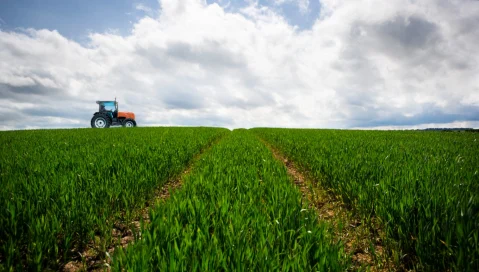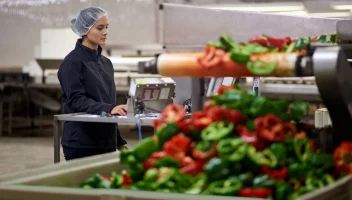Overcoming Seasonal Labor Shortages in Fresh Produce and Technology’s Role in Facing the Challenge
Overcoming Seasonal Labor Shortages in Fresh Produce and Technology’s Role in Facing the Challenge
Overcoming Seasonal Labor Shortages in Fresh Produce and Technology’s Role in Facing the Challenge
7 Sept 2021
John McCurdy
Growing fresh produce is a complicated process, necessitating precise methods and rigorous schedules. The matter of solving the sector’s chronic seasonal labor shortage is similarly complex and will require extensive collaborative effort on the part of organizations like yours to develop a more sustainable, holistic way of doing business.
The issue of an inadequate supply of farm workers is nothing new. While consumers may think back to the empty produce sections of grocery stores during the height of the COVID-19 pandemic when the topic is discussed, the fact of the matter is that the fresh industry has struggled to attract qualified employees in sufficient supply year after year.
And now, as many countries in the world are easing back into the “new normal,” the issue persists—approximately 70% of fresh produce growers and manufacturers have had difficulty recruiting the seasonal staff they need in 2021. Meanwhile, the total acreage of land that needs to be tended and quantity of crops to be harvested are both increasing, exacerbating the problem.
Through the course of this article, we’ll examine the underlying causes of seasonal labor shortages, the negative effects they have, and what strategies industry leaders are looking to use to improve the situation and ensure their operations’ futures.
What Is Causing Seasonal Labor Shortages?
The reasons behind the fresh produce segment’s labor woes can be grouped into two categories. There are those that, for the time being at least, are assumed due to the nature of the work; and then there are those that come from outside the industry via regulatory bodies and governments.
Farming is physically demanding work, requiring lifting, bending, walking, hauling and spending many hours a day outside, frequently in hot conditions. Produce pickers and packers also tend to make minimum or near-minimum wages, despite the extensive effort required on their part. This can all be attributed to the nature of the work.
Combined, those factors make these jobs much less attractive for those seeking positions, especially for young people just entering the workforce. That, in turn, has put increasing emphasis on recruiting seasonal laborers from less developed countries, where employment prospects in general are worse and make even arduous agricultural jobs in wealthier countries more attractive.
To demonstrate just how pronounced the reliance on foreigners for staffing farming operations is, consider that 73% of U.S. agriculture workers were born outside the country. Such a pronounced dependence is what leads to the next subset of issues that contribute to labor shortages: restrictions on the admission of temporary residents and immigrants.
More restrictive policies mean fewer individuals are able to move to the countries where positions are located, and recent border closings due to COVID-19 concerns did nothing to alleviate the problem. In the U.S., government programs aimed at facilitating the flow of seasonal workers like the H-2A Temporary Agricultural Program and Immigration Reform and Control Act have failed due to their restrictive nature and issues of corruption in administration.
What Are the Effects of the Labor Shortage on the Industry?
Beyond a lack of available fresh produce in retail settings, seasonal labor shortages also lead to waste. In 2020, many farms were unable to harvest crops in time to donate them to food banks, let alone offer them for sale.
More delicate fruit and vegetable varieties, like lettuce and strawberries, are even more difficult to collect without the necessary staff on-hand. And when such produce can’t even be removed from the vine due to a lack of workers, farmers must disc-up the growth just to avoid the potential production of harmful mold spores in the rotting vegetation.
Finally, while it’s difficult to put a monetary amount on how much money the fresh produce industry fails to earn due to unfulfilled staffing needs, the Natural Resources Defense Council in the U.S. estimated that even in years when a global pandemic was not compounding the issue, some $5 billion in potential revenue is lost annually through wasted agricultural materials and products.
How Can the Labor Shortage Be Addressed?
The most popular and promising methods for addressing the labor shortage issue are again best split into two varieties. The first group would be policies and new government programs that incentivize workers to choose farming, while the second is comprised of the various ways that technology can improve and streamline operations.
In the U.S., the 2021 Farm Workforce Modernization Act seems to be a step in the right direction, as it was designed with the current border control system in mind to allow for easier entry to the country for qualified individuals. Meanwhile, in the UK, the Pick for Britain initiative took a different tact, aiming to increase the number of domestic workers in farming, and it attracted 8,000 natives—amounting to 11% of the industry’s workforce in the country—in 2020.
The other area in which developments are being made to alleviate the labor crisis is automation and robotics. Among the first new technologies implemented helped to speed up the process of packing fruits and vegetables. Now artificial intelligence and imaging are being applied to quality control, assessing the size, color and shape of products to determine their validity at market.
Smart equipment is even being used in the field, with new Sweeper robots that are able to assess ripeness and pick individual peppers on their own. And while softer fruits like tomatoes still are at risk for damage when being harvested by machine, companies like Spain’s Agrobot and Harvest Croo in the U.S. are making progress with robots that can handle any sort of produce.
How Can a Purpose-Built Fresh Produce ERP Help Mitigate These Challenges?
Even amidst ongoing efforts to rectify the labor shortage and shift the burden to machines, fresh produce businesses are being forced to evolve and adjust with the times. In order to be fully prepared for this dynamic digital age, fresh produce-specific enterprise resource planning (ERP) solutions are your best bet.
These all-in-one platforms streamline and simplify otherwise cumbersome processes in a number of ways. Here are just a few of the features that the right fresh produce ERP system can provide to transform a your organization for the better:
Farmland management modules that allow for an optimized approach to usage
Complete automated data collection, eliminating the need for manual record-keeping
Demand forecasting that allows for ideal purchasing and planting
Integration with smart scanners and sensors to ensure excellent quality
Full bi-directional traceability to satisfy even the toughest of compliance mandates
Automatic scheduling of maintenance and sanitation measures
It’s critical, though, that growers, pickers and packers looking to invest in an ERP find one specifically designed for the industry, like Aptean's fresh produce ERP. With decades of collective experience and in-depth knowledge of best practices, our teams have built our solution to tackle the biggest challenges of the sector, from the management of staff to the introduction of new automation technologies at a business.
Ready to hear more about what Aptean can do to help your fresh produce business flourish while adapting to changing labor availability? Be sure to reach out to us today.
Related Content


Prêt à transformer votre entreprise ?
Nous avons les solutions ERP spécialisées dont vous avez besoin pour relever les défis de votre secteur.






